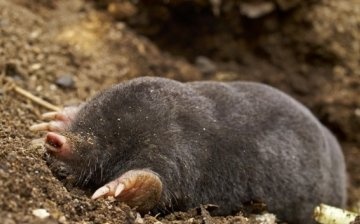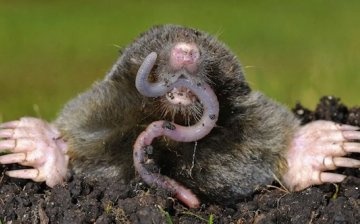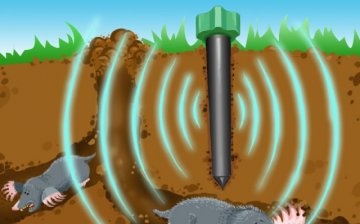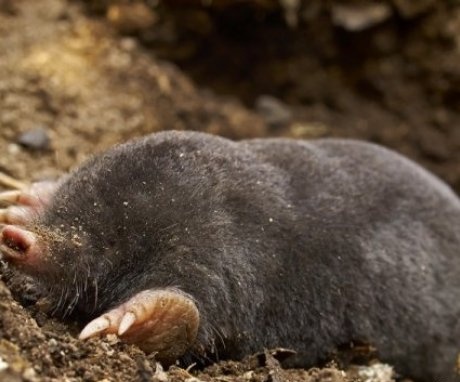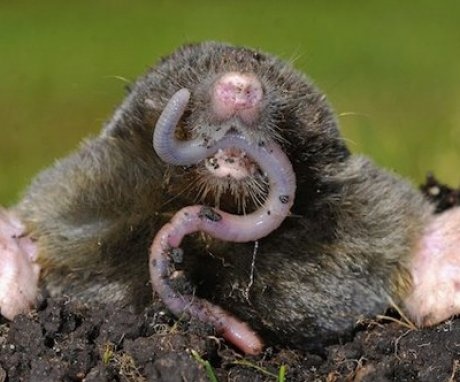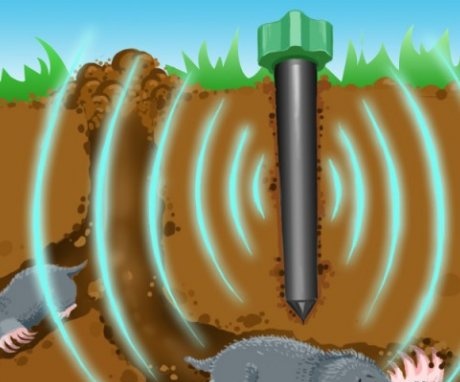All about moles: benefits, harms and effective control methods
Many gardeners are faced with such a problem as moles at their summer cottage. For the majority, this is a whole tragedy, gardeners are frightened by the heaps of earth and believe that now their harvest has come to an end. Is it so? According to agronomists and experienced growers, moles are helpers, not pests.
Yes, animals can cause some anxiety and inconvenience, but they are not comparable to the benefits that moles bring. But everything is in order. Let us understand the "pedigree" of the insectivore, in its life, we will dispel all those myths that are attributed to animals.
Content:
- Types of moles - we understand the "pedigree"
- Are they actually doing harm
- How to drive a mole from the site: modern devices
- Folk methods of struggle
- Prophylaxis
Types of moles - we understand the "pedigree"
The mole belongs to the order of insectivores, including shrews and hedgehogs. In length, the animal reaches 18 cm, sometimes less. The body is sloping, the muzzle is elongated, pointed. The paws of a mole resemble shoulder blades with five highly developed toes, at the ends of which there are long and powerful claws. The paws are pulled into the body, short, palms turned outward. The tail of the mole is small.
The fur is very dense, grows chaotically and can fit in different directions, which greatly simplifies the movement of the animal in the ground.
The mole feeds on larvae, beetles, worms and other insects. Some species will not give up on plants during periods of hunger.
In the mole population, three species are taken into account. They can be found in the forest, in clearings and meadows, less often in vegetable gardens next to a person. Allocate:
- Forest moles. They live in forests. However, if the garden plot is located next to the forest, then the mole can also visit the garden. If the forest type decides to gnaw the roots of plants, then rather it will be trees or shrubs... Forest moles are not interested in vegetables. More often, fruit trees or shrubs suffer not from the fact that they are gnawed by moles, but from the fact that tunnels are dug under them. The roots sag over the "roads" of the insectivore and, as a result, the plant grows poorly or even dies. The forest mole is characterized by a dark brown or reddish brown color, a dark stripe on the back, a light abdomen.
- Field moles. They are considered the most dangerous for the garden. They are very active in building a system of tunnels and can indulge in root crops for fun. Due to the excessive activity of the field mole, the roots of trees and shrubs can be damaged. You can distinguish this type of animal from the forest one by its color and size. It is smaller, the legs are shorter, the skin is gray-brown, and the head and its shape are very similar to the muzzle of a rodent, which is not typical for the general description of moles.
- Black moles. They will not do much harm to the garden. They do not gnaw at the roots of plants or trees, preferring to consume only larvae, beetles or worms. It is noteworthy that in Europe this species of moles is listed in the Red Book.
Regardless of the species, the mole very rarely eats the roots of plants or root crops. He will prefer insects over vegetation. Potato and carrot more likely to be eaten by mice than moles.Let's see what harm moles do and whether they do it at all.
Are they actually doing harm
There is nothing in nature that would be left unattended or used to harm. Moles actually bring many benefits to the garden:
- First, they eat the larvae of harmful insects, which can do much more harm to plants than an animal.
- Secondly, the moles loosen the soil and, thanks to their tunnels, aeration process takes place in the soil, the site will not be threatened by swampiness.
- Thirdly, the mole is the number one remedy for bear, Colorado potato beetle and others pests... If a mole lives on the site, mice and shrews are unlikely to appear, and it is they who pretty much spoil the culture.
Now let's figure out what harm moles bring. Firstly, and perhaps in the last, the animal can damage root system plants when bursting passages. The roots hang over the "roads" of the moles, as a result, the tree or shrub can wither away. There are also aesthetic inconveniences when moles live on the site. Heaps of earth everywhere touch very few people. Especially if they are scattered over an even and tidy lawn. That's all the harm.
Experienced gardeners have learned to benefit only from being close to a mole. Moreover, neither moles, nor gardeners, nor plants suffer. But first things first.
How to drive a mole from the site: modern devices
Having figured out what harm and benefit moles bring, you can begin to "drive out" the animal. Agronomists advise against driving moles away forever. Why? From April to June, harmful insects wake up very actively in the garden area, develop, reproduce. The larvae actively eat young plants. In a word, spring and the first month of summer is the time for active eating of crops. pests... The mole will help get rid of the larvae in April, let him destroy the enemies of the plants, and then politely ask him from the site in humane ways for several months, when the root system of crops begins to grow.
You can drive out the orderly with the help of modern technologies and folk methods. Both those and others have proven themselves. The mole leaves for two to three months, just during the period of active plant growth.
The most effective device for expelling moles is considered to be an ultrasound machine.
He gently and unobtrusively drives the animal away from the garden. True, along with the moles, all useful insects leave. Keep this in mind. There will be no one on the site for 2-3 months. Why does the animal leave? The fact is that moles have a very keen sense of touch, smell and hearing. They react painfully to vibration, unpleasant sounds, and smells.
The device works on this principle. It emits ultrasonic noises, which are caught by the animals, they cannot tolerate them, they get scared and leave the site. This method is considered one of the most humane and effective. The persecution of moles begins in June, when they have already done the main work useful for the garden.
Folk methods of struggle
Traditional methods are based on the same principles as an ultrasound machine. They are designed to scare the animal with noise, to stop exits to the surface with unpleasant odors. Only the most effective and humane ways of dealing with a mole are described here.
Experts do not advise to fill burrows and exits with chemicals - the soil will be harmed, and hence the plants.
The moles will still leave and then return again. It is impractical to use oil products and other monstrous means, they will primarily harm crops and the person himself later. Let us be reasonable people and adopt proven, simple and humane methods.
- "Empty plastic bottle." The method is based on noise intolerance to moles. An empty plastic or glass bottle is driven into the ground with the neck up. The air swirls created by the wind in the neck of the bottle emit a hum and whistle. The animals are frightened by the constant noise and leave.The bottle must be monitored so that no water is poured into it, otherwise the entire noise effect will disappear. The method has proven itself and is recommended by experienced gardeners.
- We plant "odorous" plants. Marigold, dill, parsley, celery - all these plants do not tolerate moles. Plant them all over the site, decorating them in decorative curtains. Just by the end of June, they will grow up and begin to emit an unpleasant smell for moles. Procure in advance seedlings and plant the plants as early as May. The moles leave until the plants dry out in the fall.
- Tin cans guard the garden. Another "noisy" way. Works flawlessly until structures are removed. For installation, you need an iron stake that looks like a scrap. It is pushed into the ground as deep as possible. Empty cans are hung on the stake. In windy weather, cans knock on iron, an unpleasant sound goes into the ground and forces the moles to leave the garden. The animal does not appear until the structure is removed. Many have tried this method and were very satisfied. Nobody was hurt, all cultures remained healthy.
- Fish waste. Fish waste - heads, entrails - are laid in the exits of wormholes. Insectivorous animals do not tolerate the smell of rotten fish and hastily retreat home. The disadvantage of this method is that over time, the waste of the fish will inevitably rot, the smell becomes thinner and disappears - the moles can return. However, initially it works flawlessly!
All these methods of dealing with moles have been tested and work flawlessly. They harm neither the soil, nor the plants, nor the moles themselves. As a result, the vegetable garden is safe, the larvae were destroyed in the spring - it remains to harvest the harvest, safe and sound.
Prevention
It is quite difficult to prevent the appearance of moles, especially if the area is near a forest, the soil is moist and loose.
Gardening tips:
- Many people fence off the perimeter with underground barriers. Slate or other protective materials are dug in to a depth of 1-1.5 m. They must be dense and withstand the negative effects of moisture. Such a fence is built not only into the ground, but also taken out to a height of a meter or less.
- Plants that emit strong, spicy odors are also used as protection. They fenced the entire site around the perimeter. Legumes will scare away animals. Plants are also placed around the perimeter of the site. If there is a risk of moles appearing, tin cans are attached to the posts (iron) of the fence. So the garden around the entire perimeter will be protected by a "noise" curtain.
- Many novice gardeners try in the spring to destroy all the "provisions" of moles - larvae, bugs, spiders, worms. The site is almost filled with chemicals - insecticides. Moles may not appear, but the soil will suffer from a chemical attack. Moreover, most larvae and pests are underground, the chemical will not reach them there anyway. Therefore, the use of such "prevention" is impractical and even harmful.
- To prevent the appearance of moles, it will be sufficient to install an underground fence or install a "noisy" background around the perimeter.
It is not difficult to drive the animals away, the main thing is to treat this task reasonably and humanely. Simple devices and special plants will help ward off the "digger". However, is it worth kicking him out forever? It is up to the gardener to decide. There are many benefits from the animal, in fact, there is not much harm. There are no imperfections in nature, if a mole is born on the site, it means that there are many parasites that can do more harm to crops than he himself. It is worth thinking about.
More information can be found in the video:




